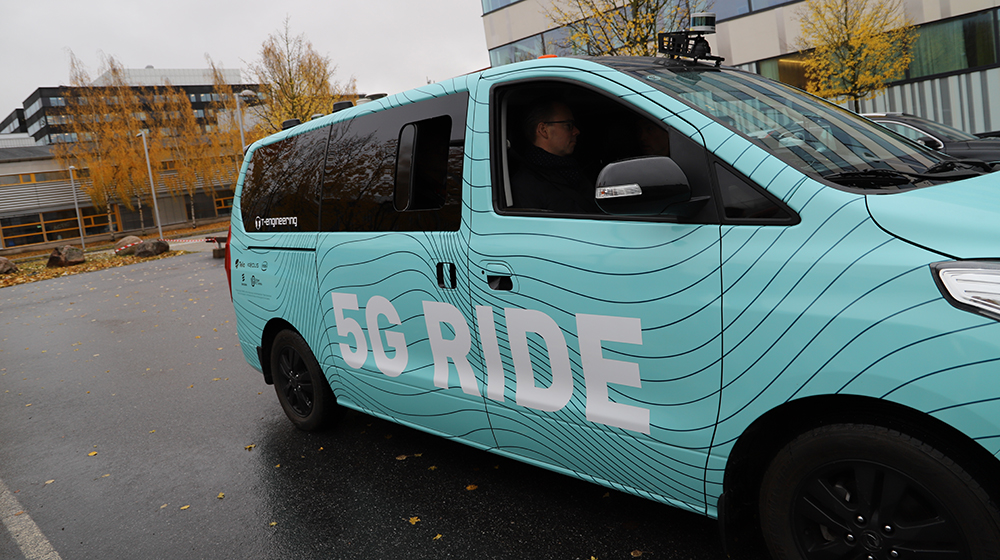Multi-million investment in development of connected, autonomous vehicles

The next phase in the development of the 5G Ride project, focusing on the public transport of the future. The ongoing collaboration on 5G connected, self-driving buses operated by Kista Science City, Keolis, Telia, Ericsson, KTH ITRL, T-engineering and Intel has been further strengthened in the form of 31 million SEK, of which almost half is financed by FFI, and new project partners in Scania and Viscando.
Future 5G Ride is a development of the 5G Ride project , which since 2020 has been working on solutions for smooth introduction of self-driving buses in a real urban environment, with the help of 5G and remote monitoring of vehicles via the traffic tower.
“Driverless vehicles have the potential to improve road safety and streamline the use of our roads. A critical success factor for future public transport is how well it interacts with other services and how efficient it is when there is a mix of mobility services available. By exploring the possibilities that come with technologies such as 5G, AI and smart traffic sensors, the Future 5G Ride project will take a collective approach to these issues”, says Karin Bengtsson, CEO of Kista Science City AB.
An important novelty in the project is the use of smart traffic sensors from Viscando, sensors that measure accurate positions and paths for road users and send these in real time to Ericsson's innovation cloud where the information is processed, e.g. combined with data from other sources, and finally shared with the autonomous vehicle. The vehicle acts on the basis of the overall image, from sensors, traffic towers, own cameras and surroundings. All this in real time. The information from the infrastructure sensors significantly improves situational awareness in complex traffic, the vehicle receives accurate information about hidden road users and their expected behavior, which makes the journey safer and also allows higher speeds. These functions will be tested on vehicles from Scania and T-engineering.
The ambition of the project is to create conditions for efficient and sustainable public transport where operators in the traffic tower handle fleets of autonomous, electric vehicles in order to improve traffic planning and reduce energy consumption. By taking a collective approach and combining technologies to take the next step in the development of driverless automated vehicles. To create a more environmentally smart and cost-effective transport system that feels safe and accessible to travellers.
“Many technical and non-technical issues are understood first when systems are tested in realistic environments. These projects, where academia, industry and the public sector work together with experiments, tests, end demonstrations, are very important for the fundamental challenges of connected vehicles and the benefits they will bring. KTH's contribution to the project is an integration of ITRL's test bed for connected vehicles for experimental research on shared sensor data and situation understanding, and its requirements for connection”, says Jonas Mårtensson, director of ITRL.
“I look forward to continuing this exciting project. We are now establishing the world's first live 5G lab in Kista, testing new applications for self-driving, connected vehicles and drones. With the help of innovative cloud technology, real-time digital twins and HD mapping, we explore how to increase safety, reduce costs, enable new business models and make sustainable transport a reality", says Stig Persson, Program Manager, Ericsson.
“This type of project, bringing core competences form different companies and academia together, is an important enabler for research and development on new emerging technologies. In this project, we will research on how shared sensor data between a vehicle and infrastructure can be used to increase the perception horizon and by that improve the situational awareness. A good situational awareness is a key ability for safe and efficient autonomous driving”, says Henrik Pettersson, Senior Technical Advisor, Scania CV.
About 5g Ride
The project is in collaboration between some of Sweden's leading companies in mobility and technology. The project is run by Kista Science City AB, and the bus company Keolis. KTH ITRL provides and integration of ITRL's test bed for connected vehicles for experimental research on shared sensor data and situation understanding, and its requirements for connection. Ericsson contributes with innovation cloud and the technical solutions for the 5G-connected traffic tower and, together with Telia, has delivered the 5G network that enables the self-driving vehicle from T-engineering to continue rolling. Viscando's 3D and AI based traffic sensors will improve the perception of the situation for increased safety and more efficient driving. Scania will equip a vehicle for data collection and functional test, develop and evaluate situational awareness functionalities based on data sent from traffic sensors.

